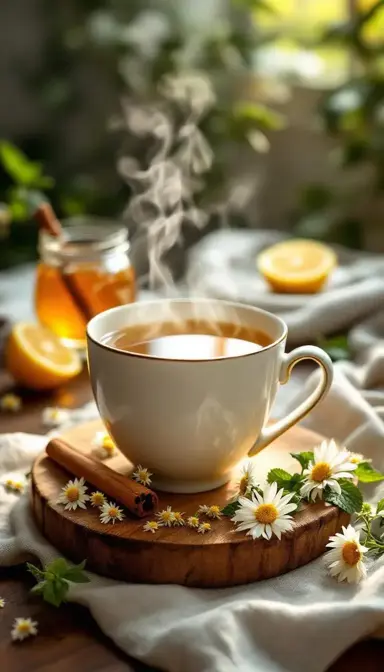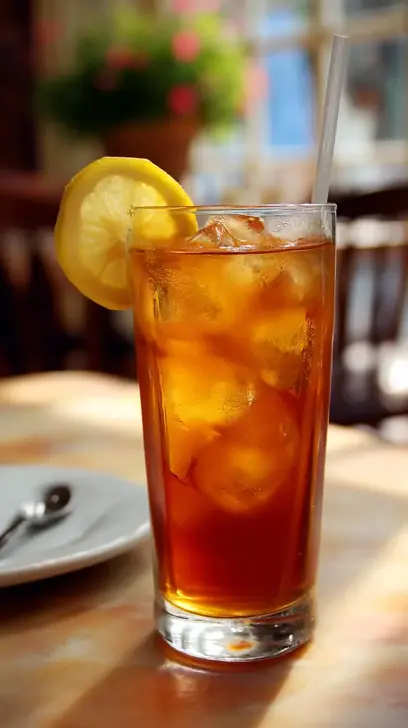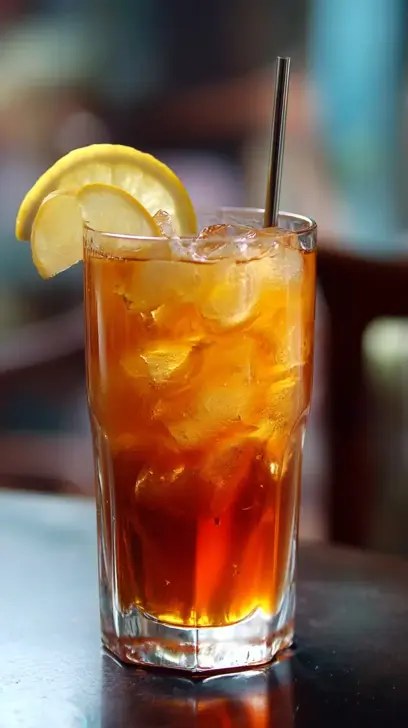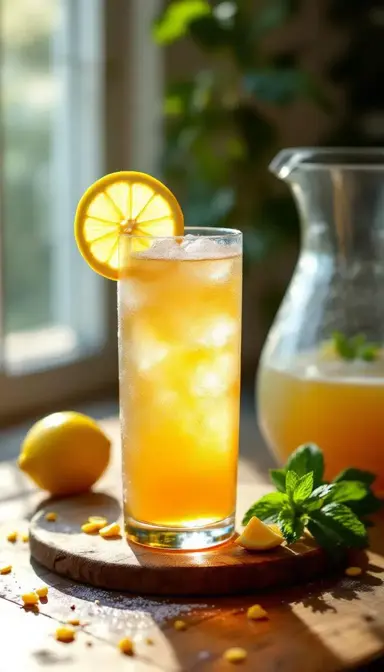There’s something almost magical about a steaming cup of herbal tea—the way the fragrant steam rises, carrying whispers of chamomile meadows, spicy ginger fields, or cool mint gardens. Unlike its caffeinated cousins, herbal tea is a gentle companion, perfect for quiet mornings, winding down evenings, or those moments when you just need a little comfort in a cup.
What I love most? The freedom to play. Whether you’re blending for relaxation, digestion, or just pure flavor, herbal tea is your canvas. And the best part? You don’t need fancy equipment or rare ingredients. Just a handful of herbs, hot water, and a little patience.
Why This Recipe Works
- A Moment of Calm – Chamomile and lavender are like a warm hug for your nervous system.
- Digestive Ease – Ginger and peppermint? Your stomach will thank you.
- Vibrant, Caffeine-Free Hydration – Hibiscus and rosehips bring color and antioxidants without the jitters.
Essential Ingredients & Tools
Ingredients for the Base Tea
- 1 tbsp dried chamomile flowers – Soft, honey-like, and perfect for unwinding. (Swap in lavender if you want something a little more floral and earthy.)
- 1 tsp fresh ginger, thinly sliced – That warm, spicy kick? Yes, please. (Dried ginger works too—just use half the amount.)
- 5–6 fresh mint leaves – Crush them between your fingers first to release their bright, cooling oils.
- 1 tsp dried hibiscus petals – Tart, ruby-red, and packed with vitamin C. (Rosehips are a sweeter alternative.)
- 2 cups filtered water – Because good tea starts with good water.
Optional Enhancements
- A drizzle of honey or maple syrup – For when you want a touch of sweetness.
- A cinnamon stick – Adds warmth and depth—like a cozy blanket for your tea.
- A slice of lemon or orange – A citrusy lift that brightens everything up.
Tools You’ll Need
- A teapot or infuser (or just a mug and a fine-mesh strainer).
- A kettle or small saucepan (no need to go full barista—just heat the water gently).
- A timer (over-steeping can turn your tea bitter, and nobody wants that).
- Your favorite mug (because tea tastes better in a vessel you love).
How to Make Herbal Tea
- Heat the Water Just Right
Bring your 2 cups of filtered water to about 200°F (93°C)—just shy of a rolling boil. Delicate herbs like chamomile and mint can lose their magic if scalded. Pro tip: If you don’t have a thermometer, watch for small bubbles (think “fish eyes”) rising to the surface. - Layer Your Herbs
Place the denser ingredients (like 1 tsp fresh ginger, thinly sliced) at the bottom of your infuser and the lighter ones (like 1 tbsp dried chamomile flowers) on top. Gently crush the 5–6 fresh mint leaves before adding them—this releases their essential oils for a more aromatic brew. - Steep with Care
Pour the hot water over the herbs, cover (to trap all those lovely aromas), and let it steep for 5–7 minutes. Resist the urge to stir—agitating the herbs can make the tea bitter. - Strain and Savor
Pour the tea through a fine-mesh strainer, pressing lightly on the herbs to extract every last drop of flavor. But don’t squeeze too hard—tannins (the compounds that make tea bitter) lurk in overworked herbs. - Add the Finishing Touches
Stir in honey or maple syrup or a slice of lemon or orange while the tea is still warm so they dissolve evenly. If you’re making Iced Tea, pour it over ice immediately to lock in freshness, or try cold-steeping overnight for a mellower, smoother sip.
Pro Technique
Temperature Matters
Delicate flowers (chamomile, lavender) prefer 200°F, while hardy roots (ginger, licorice) can handle boiling water. Too hot, and floral notes turn grassy. Too cool, and roots won’t fully infuse. A variable-temperature kettle is handy, but if you don’t have one, just let boiling water sit for 30 seconds before pouring.
Layering Flavors Like a Pro
For complex blends, steep ingredients in stages:
- Roots (10 minutes)
- Leaves (5 minutes)
- Flowers (3 minutes)
This keeps flavors balanced and prevents any one note from overpowering the others.
Cold-Steeping for Smoothness
Some herbs (like hibiscus or citrus peels) shine when steeped cold. Just combine with water and refrigerate for 12+ hours. The result? A bright, tannin-free tea that’s incredibly refreshing.
Chef’s Wisdom
- Dried vs. Fresh Herbs – Dried herbs are 3x more potent, so use 1 tsp dried or 1 tbsp fresh per cup.
- Toasting Spices – Lightly toast cinnamon or cardamom in a dry pan before steeping—it deepens their warmth.
- Balancing Flavors – Tart hibiscus needs honey’s sweetness; ginger’s heat pairs beautifully with cooling mint. For bedtime blends, a pinch of vanilla powder adds creamy comfort.
Storage & Freshness Guide
- Dried Herbs – Store in airtight glass jars away from light and heat (good for 6 months). Freeze delicate petals like chamomile to extend their life.
- Fresh Herbs – Wrap mint or lemon balm in damp paper towels and refrigerate (up to 1 week). Woody herbs (thyme, rosemary) can be stored in water like cut flowers.
- Brewed Tea – Refrigerate for 48 hours in a sealed pitcher. Reheat gently—no boiling, or you’ll “cook” the flavors. Leftover tea? Freeze into ice cubes for smoothies or cocktails.
Nutrition Profile
Herbal tea is naturally light and hydrating. Per cup (unsweetened):
- Calories: 2
- Fat: 0g
- Protein: 0g
- Carbs: 0.5g
- Fiber: 0g
Ingredient Variations and Their Impact
- Chamomile → Lavender – More floral, slightly earthy. Add rose petals for a romantic twist.
- Ginger → Turmeric – Earthy, anti-inflammatory. Pair with black pepper and coconut milk for a golden latte.
- Mint → Lemon Balm – Citrusy and mild. Mix with lemongrass for a Thai-inspired zing.
- Hibiscus → Rosehips – Less tart, higher in vitamin C. Add dried orange peel for marmalade-like depth.
- Sweeteners – Swap honey for maple syrup’s caramel notes, or infuse honey with vanilla or lavender for gourmet flair.
Perfect Pairings
Complementary Dishes
- Spicy Thai Curry: Iced peppermint tea with lime cools the heat. The menthol in mint contrasts the spice, while lime adds a refreshing zing.
- Buttery Shortbread: Chamomile’s honeyed notes mirror the cookie’s richness, while its lightness cleanses the palate.
Something Sweet
- Dark Chocolate Truffles: Hibiscus tea’s tartness cuts through cocoa’s intensity. Pair with sea salt-dusted truffles for a balance of sweet and savory.
- Lemon Poppy Seed Cake: Ginger tea’s warmth highlights the cake’s citrusy brightness, creating a harmonious flavor duo.
Digestive Pairings
- Fennel Seed Biscotti: Licorice root tea mirrors fennel’s anise-like sweetness, making it a perfect post-meal treat.
- Fresh Fruit Salad: Light, floral lavender tea enhances berries’ natural sugars without overpowering their delicate flavors.

The Art of Crafting Herbal Tea: A Warm, Flavorful Ritual for Mind and Body
Learn how to make the perfect cup of Herbal Tea with my easy, customizable recipe. Soothe your senses and sip on something special. Brew your own today!
Ingredients
For the Base Tea
-
1 tbsp dried chamomile flowers
-
1 tsp fresh ginger (thinly sliced)
-
5–6 fresh mint leaves
-
1 tsp dried hibiscus petals
-
2 cups filtered water
Optional Enhancements
-
1 tsp honey or maple syrup
-
1 cinnamon stick
-
1 slice lemon or orange
Instructions
-
Heat 2 cups of filtered water to 200°F (93°C).01
-
Layer herbs in a teapot or infuser, placing 1 tsp fresh ginger, thinly sliced at the bottom and 1 tbsp dried chamomile flowers on top. Gently crush 5–6 fresh mint leaves before adding.02
-
Pour hot water over herbs, cover, and steep for 5–7 minutes.03
-
Strain tea into a mug, pressing lightly on herbs.04
-
Stir in 1 tsp honey or maple syrup or 1 slice lemon or orange while tea is warm.05



